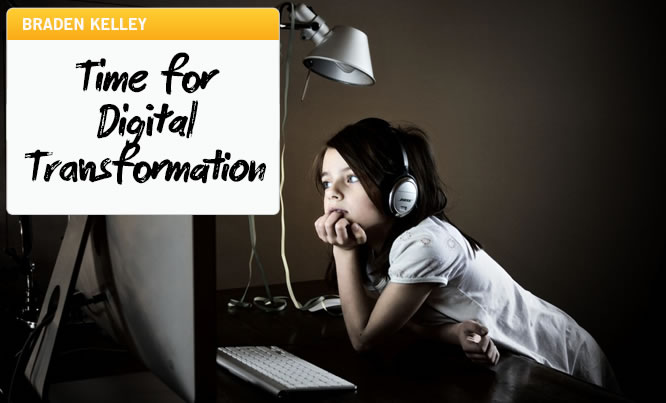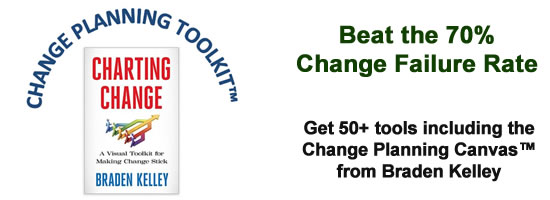Time for Digital Transformation is Now

The pace of change is accelerating.
Much has changed since we all started to dial in with our modems and connect to online services like America Online or Compuserve and eventually directly onto the Internet and the World Wide Web. Elements of our digital world continue to invade our language and our consciousness.
- “Text me later.â€
- “Skype me tomorrow.â€
- “Google it.â€
- “#hashtagâ€
- “rtoflâ€
Whether we like it or not the physical world and the digital world, and people are more likely to freak out about leaving their mobile phone at home than their wallet. Soon you won’t even need to carry a wallet (unless you want to). Canada stopped making pennies. In Sweden many businesses no longer take cash. Have you tried buying a drink on an airplane lately? (no cash accepted there either)
We now live in a digital age.
Not because technology is new, but because the way we react to technology and interact with it is different.
We’ve had technology for a while, but we used it primarily for performing calculations, and then for information storage and retrieval. But now, because the computer has moved from being a machine in a lab programmed with punch cards, to something nearly every one of us carries in our pocket or wears on our wrist, we’re beginning to form relationships with machines and more importantly, to use our machines to form, maintain, and even deepen, our human relationships.
So what does this mean for you as a business person?
It means that people like me have to drag you kicking and screaming away from the way you’ve always done business, away from the way you’ve always structured your enterprise, away from the ways you’ve facilitated communication among employees and between you and your customers, partners, and suppliers and towards a fundamentally different way of organizing and operating your business.
Are you ready to do business in a digital way for the digital age?
No?
Well, your market is large and attractive to me and my digital native friends. While you struggle under the weight of your legacy systems and the denial that you must change how you think, change how you interact with customers, change how your business works inside, maybe we will re-imagine your business and your entire industry from the ground up with a collection of digital strategies that utilize the power of the digital mindset to more efficiently and effectively utilize people, process and technology with some venture capital backing to challenge the incumbents and put them out of business. People are fascinated with startups like Uber and with good reason, but they should also be looking at what established technology companies like Amazon are doing because you’re either have to think like a technology company or go out of business.
In my next article on digital transformation we will circle back to discuss Uber in a bit more detail as we explore the difference between a digital strategy and a digital transformation. Because they are not the same and are vastly different in what they require to be successful. The one thing they both have in common is that they will inflict change (in varying amounts) upon the organization, and with a more visual, collaborative approach to planning that change – like that enabled by the Change Planning Toolkit™ that I introduce in my new book Charting Change – you will increase your odds of beating the 70% change failure rate and successfully achieving your digital change goals.
Stay tuned!
 Now you can buy the Change Planning Toolkit™ – Individual Bronze License – Advance Purchase Edition here on this web site before the book launches.
Now you can buy the Change Planning Toolkit™ – Individual Bronze License – Advance Purchase Edition here on this web site before the book launches.
This article originally appeared on Linkedin
 Wait! Before you go…
Choose how you want the latest innovation content delivered to you:
- Daily — RSS Feed — Email — Twitter — Facebook — Linkedin Today
- Weekly — Email Newsletter — Free Magazine — Linkedin Group
 Braden Kelley is a popular innovation speaker, builds sustainable innovation cultures, and tools for creating successful change. He is the author of the five-star book Stoking Your Innovation Bonfire and the creator of the revolutionary new Change Planning Toolkitâ„¢. Follow him on Twitter (@innovate) and Linkedin.
Braden Kelley is a popular innovation speaker, builds sustainable innovation cultures, and tools for creating successful change. He is the author of the five-star book Stoking Your Innovation Bonfire and the creator of the revolutionary new Change Planning Toolkitâ„¢. Follow him on Twitter (@innovate) and Linkedin.
NEVER MISS ANOTHER NEWSLETTER!
LATEST BLOGS
Three things you didn’t know about credit cards
Photo by Ales Nesetril on Unsplash Many of us use credit cards regularly. From using them for everyday purchases to…
Read MoreFive CV skills of a business-minded individual
Photo by Scott Graham on Unsplash The skills listed on a CV help employers quickly understand your suitability for a…
Read More


